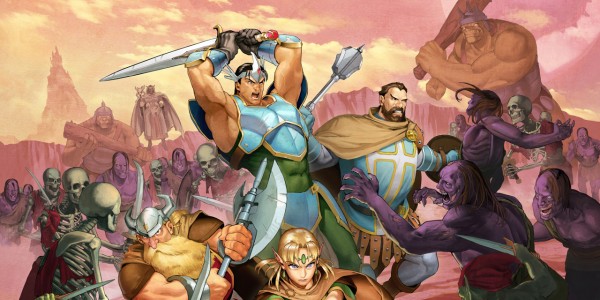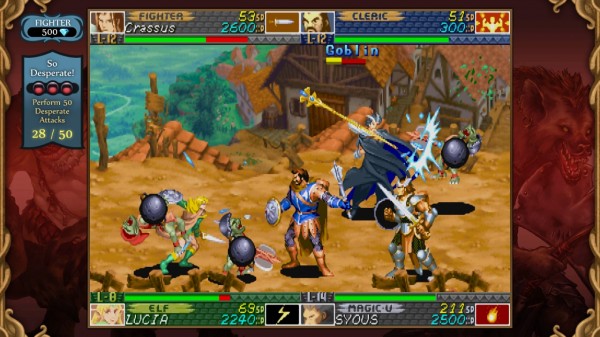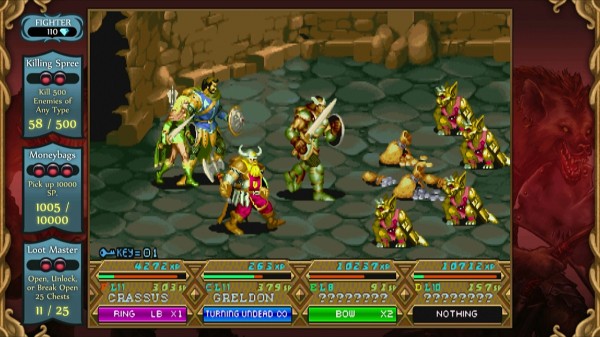Porting a classic arcade game to the current generation of game consoles is a risky gambit. Some, like The Simpsons Arcade, capture nostalgia in a bottle, bringing us all back to times of innocence. Others, like Dungeons and Dragons: Chronicles of Mystara, struggle in their quest to light the pyres of our memories. Sure, the two games in the package are fun, but their arcade roots betray them, in a sense, limiting the experience.
The two games, Tower of Doom and Shadow over Mystara, have been recreated faithfully; the same great class-based, story-branching gameplay that D+D fans enjoyed back in 1993 is fully intact here. Both games take the old arcade beat-em-up format and expand on them with spells, a level-up system, and more. However, there’s a big part of the fun missing from these games, something that would inevitably be lost in the midst of modern technology: the challenge.
For those too young to remember, the typical arcade game was not made simply for player enjoyment; these games were made to separate every person who walked into the arcade from his or her money. The difficulty level of some games was absurd, to the point of knowing that we might blow through an entire roll of quarters without accomplishing our goal. Ask anyone who’s ever faced M. Bison or Shao Kahn or even Mr. Burns on an arcade machine and they’ll tell you; those stages were HARD.
Both games in Chronicles of Mystara are filled with these money-sucking challenges. Insane numbers of enemies, brutal bosses, long campaigns: every element is there. The problem that arises from porting these games to modern hardware is this: without the limitation of a finite amount of money, the challenge is eliminated. The repercussions of being killed before killing no longer exist. I can die and die and die some more without ever having to worry about starting over. The continue countdown that haunted my nightmares in countless games is laughable now; the mad dash to pull the next quarter out of my pocket is no longer necessary.
This shouldn’t be a big deal, since the two games are otherwise perfect ports, but not having to worry about a forced financial restart changes EVERYTHING. I no longer fear any challenge the game throws at me like I used to, and the path choices that used to require some deep thought now are decided at random, as I’m guaranteed to succeed either way.
There’s a point in Tower of Doom where I had to choose between walking around a mountain and fighting normal enemies, or walking through it and fighting a fearsome dragon called Flamewing. Flamewing sports a giant life bar and some crazy one-hit kill tactics, making him even more difficult than the final boss Deimos. A tough choice standing in a 1993 arcade listening to the coins jiggle in my pocket, but not so tough in 2013 sitting in my office.
That’s where Chronicles of Mystara falls short: the games are total free play, offering unlimited continues to the player, which takes the difficulty level from a ten to a measly one. Who cares if Flamewing burns my ass ten times? I’ll come back an eleventh and finish the job. The Simpsons Arcade Game realized this could happen, inserting a 40 quarter limit on a 4-player co-op experience. By doing this, the tension of “oh crap we better be careful or we’re toast” remains a part of game. Capcom decide to maintain the free play route, which works with ports of fighting games like Darkstalkers Resurrection and Street Fighter III: Third Strike, but not with adventures like these two.
The arcades of my youth are long gone, and with them go the challenges only a room filled with flashing lights and a cacophony of familiar sounds can provide. In its attempt to bring this nostalgia back, Dungeons and Dragons: Chronicles of Mystara trips at the finish line, ironically similar to running out of quarters at the last boss.





















I think this review raises a really valid point about difficulty in arcade ports like these. If you play Final Fight on the SNES, or any number of 16-bit arcade ports at the time, they were reworked to give the player limited lives, even if he changed the difficulty to easy. But in more recent years they give a straight emulation and just allow you to keep pumping virtual quarters like you are playing it in MAME.
They could actually re-release this game on another platform as a model closer to free-to-play and have you buy virtual quarters when you start and continue. Perhaps if it wasn’t at nearly the cost that it was as an arcade machine (for instance, a dollar gets you 30 lives rather than just 12) it would still provide some challenge and incentive not to die too much.
Then have it so you also have the option to buy it outright from the start at the same price it’s at now. You’d get the chance to beat it without paying full price if you’re a good player. But if you continue so much that you pay as much as the full price it unlocks it so that you don’t have to pay any more for virtual quarters. Whatever the case, it could still have a mode as default that limits the number of lives and continues and make it so achievements and trophies can only be done in that mode and “free play” is considered “practice mode” in the options.
A friend adds that he used to entertain himself with his Neo Geo by making his own challenges, like seeing how many times he could beat Cyber Lip on only 4 continues, eventually improving his game down to 1. Then he says that some later AES games did change to adding a home difficulty mode like Metal Slug and KOF. I remember almost all Genesis and Super Nintendo games altered the difficulty of arcade ports so that you had limited lives and continues. But that wasn’t always the case with the retro/anthology collections on PS1/PS2.
He also says that prior to Metal Slug and KOF you could still use the Neo Geo’s memory card to continue where you wanted (select your starting stage).
More info:
http://www.neogeoprotos.com/memcardfaq.htm
http://www.digitpress.com/forum/showthread.php?76563-Stuff-you-can-do-with-a-Neo-Geo-memory-card&s=394c343c17acea9bb2d08867a44ca0c4&p=894625&viewfull=1#post894625
I like that idea – paying per continue until the full game price is reached. It’s great for gamers, but I feel like publishers wouldn’t like that because there is only a way to decrease cost rather than increase it, and we know they want to balance those two (or just make things cost more).